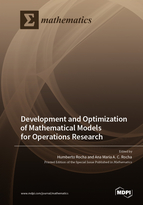Development and Optimization of Mathematical Models for Operations Research
A special issue of Mathematics (ISSN 2227-7390). This special issue belongs to the section "Engineering Mathematics".
Deadline for manuscript submissions: closed (31 July 2022) | Viewed by 19162
Special Issue Editors
Interests: optimization; applied mathematics; operations research; computer science
Special Issues, Collections and Topics in MDPI journals
Interests: global optimization; non-linear optimization; integer-mixed programming
Special Issues, Collections and Topics in MDPI journals
Special Issue Information
Dear Colleagues,
Programming theory of the optimization model, queuing theory of the queuing model, and game theory of the game model are the first three important branches of operations research. The development of mathematical models and their optimization are fundamental for the effective resolution of many problems in operational research. In recent years, increased insights into real-world problems have led to the development of new mathematical models, new optimization algorithms, or both, contributing to the development of a research area with increasing practical relevance.
This Special Issue is dedicated to works at the interface between mathematical modeling, optimization and operations research with a special focus on real-world applications. In addition to research papers, high-quality review articles on mathematical models/algorithms developed for a challenging real-world application are welcome.
Topics of interest include (but are not limited to):
* Mathematical models/Optimization: continuous and discrete optimization, linear and nonlinear optimization, derivative-free optimization, deterministic and stochastic algorithms, nature-inspired algorithms and other metaheuristic algorithms;
* Applications: all areas of sciences, engineering and industry, including economics, medicine, biology, earth sciences and social sciences.
Prof. Dr. Humberto Rocha
Prof. Dr. Ana Maria Rocha
Guest Editors
Manuscript Submission Information
Manuscripts should be submitted online at www.mdpi.com by registering and logging in to this website. Once you are registered, click here to go to the submission form. Manuscripts can be submitted until the deadline. All submissions that pass pre-check are peer-reviewed. Accepted papers will be published continuously in the journal (as soon as accepted) and will be listed together on the special issue website. Research articles, review articles as well as short communications are invited. For planned papers, a title and short abstract (about 100 words) can be sent to the Editorial Office for announcement on this website.
Submitted manuscripts should not have been published previously, nor be under consideration for publication elsewhere (except conference proceedings papers). All manuscripts are thoroughly refereed through a single-blind peer-review process. A guide for authors and other relevant information for submission of manuscripts is available on the Instructions for Authors page. Mathematics is an international peer-reviewed open access semimonthly journal published by MDPI.
Please visit the Instructions for Authors page before submitting a manuscript. The Article Processing Charge (APC) for publication in this open access journal is 2600 CHF (Swiss Francs). Submitted papers should be well formatted and use good English. Authors may use MDPI's English editing service prior to publication or during author revisions.
Keywords
- Optimization
- Continuous and discrete optimization
- Linear and nonlinear optimization
- Derivative-free optimization
- Mathematical modeling
- Deterministic and stochastic algorithms
- Operations research
- Mathematical programming
- Programming theory
- Decision theory
- Game theory
- Queuing theory
- Reliability theory
- Real-world applications






